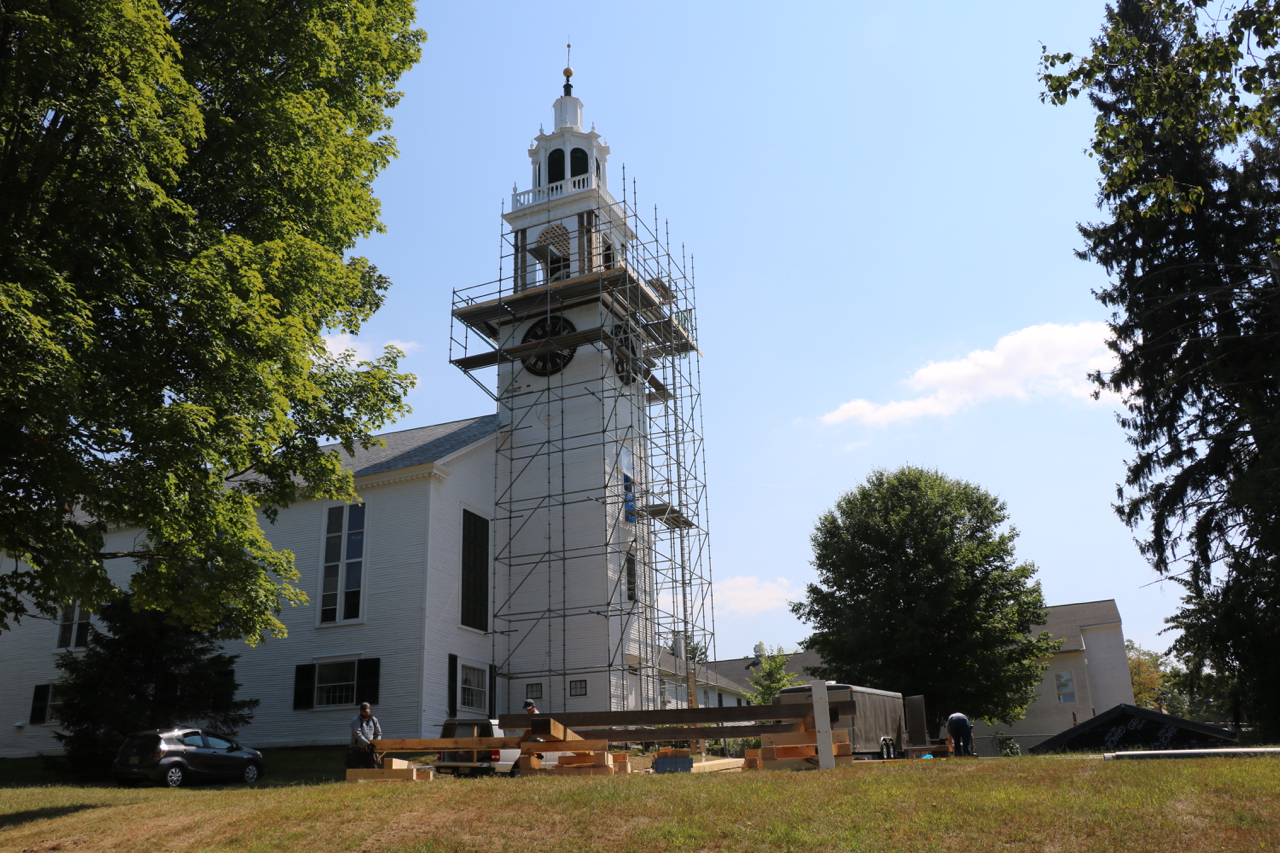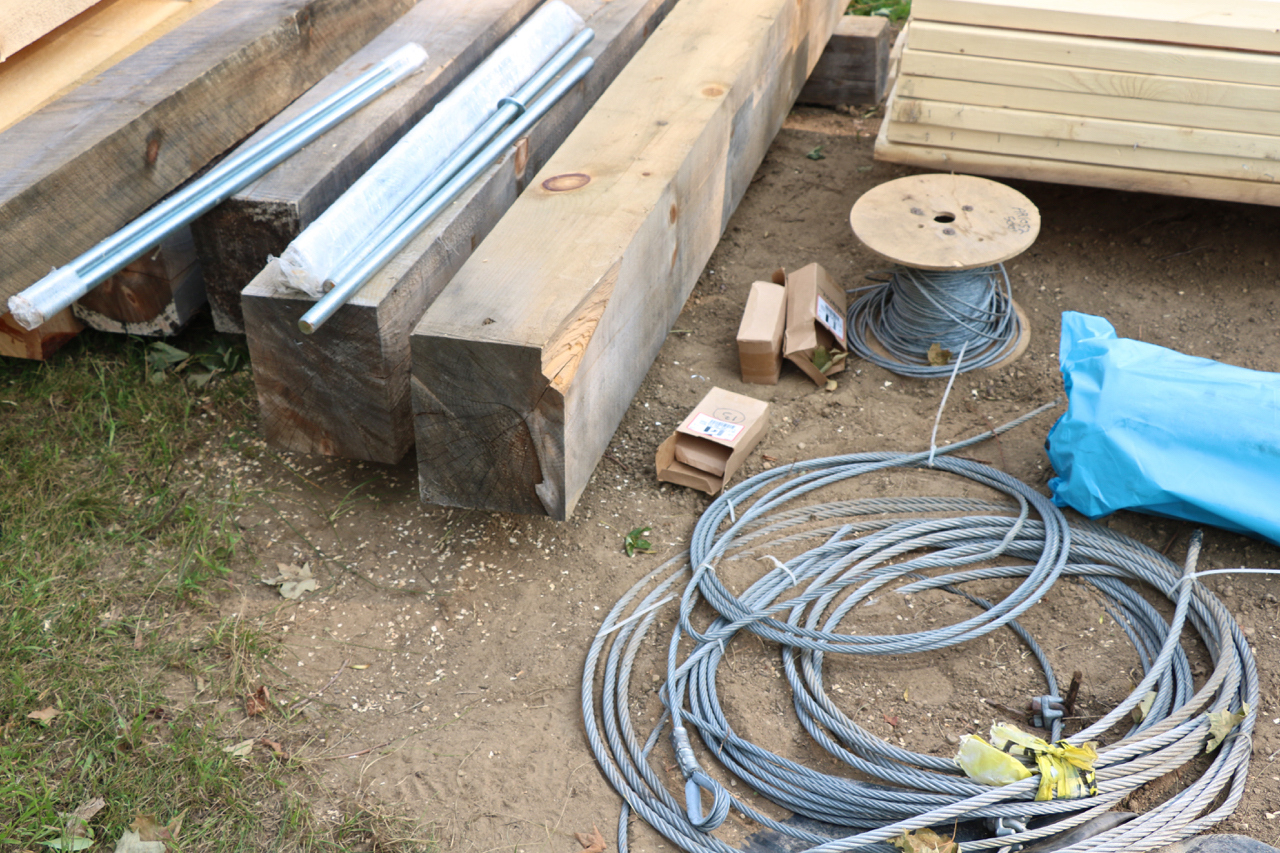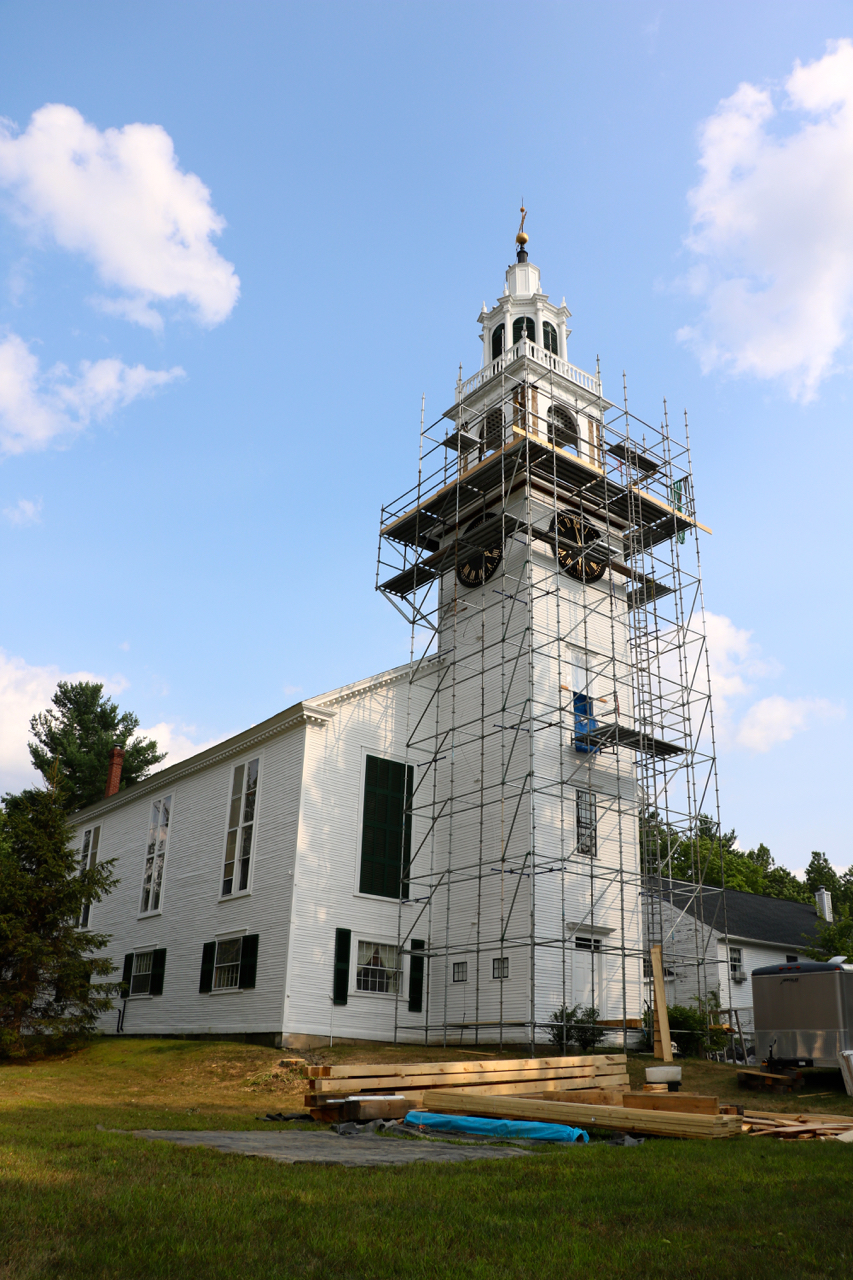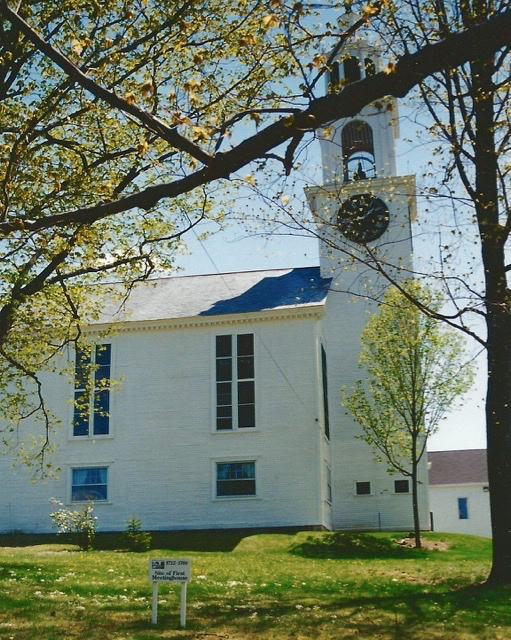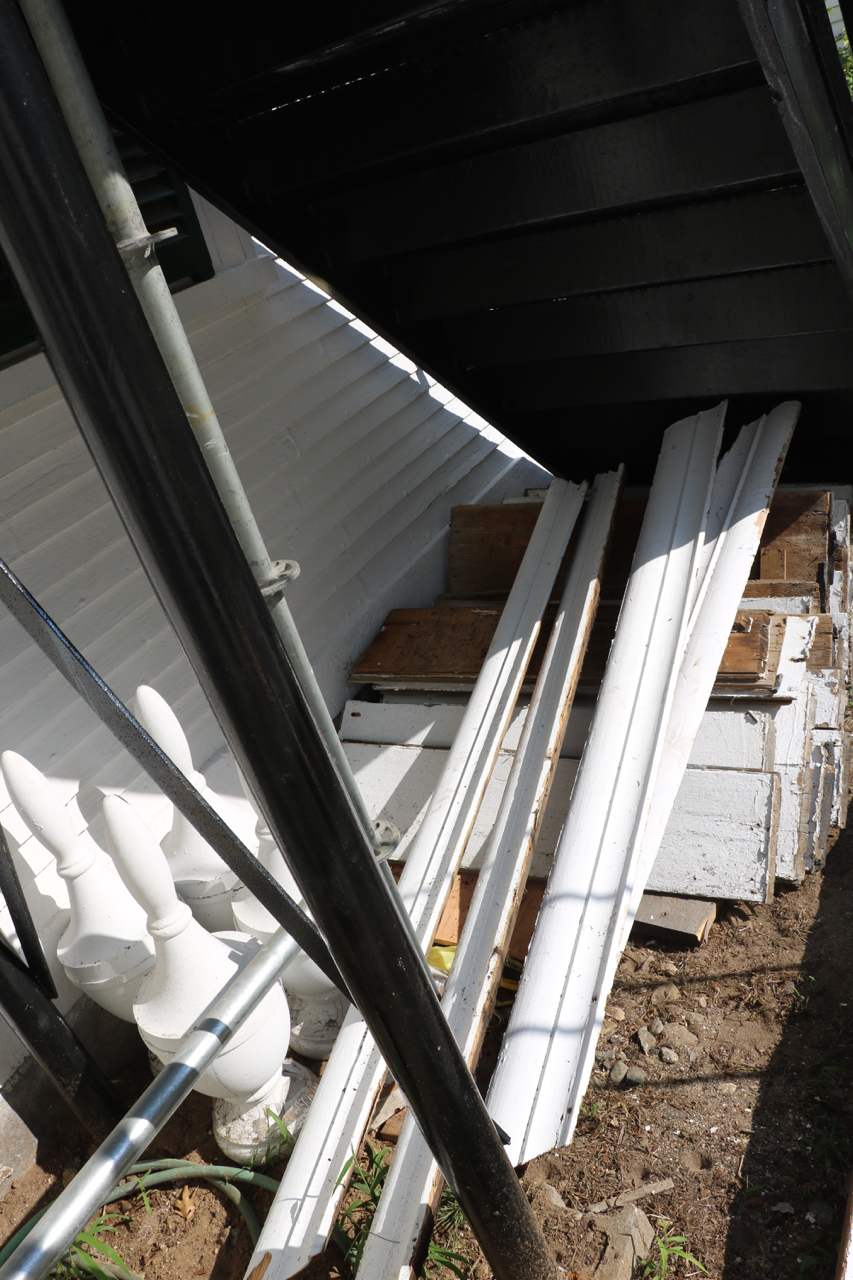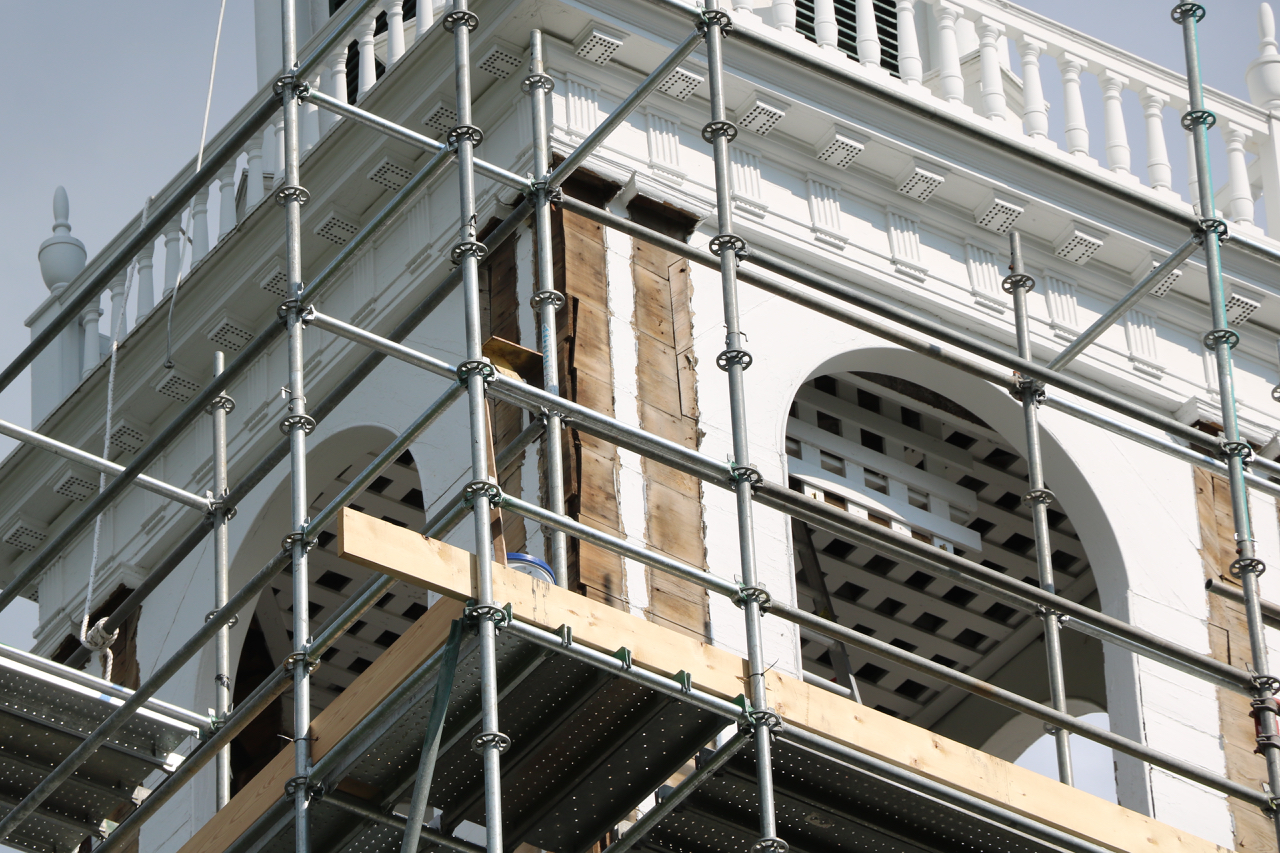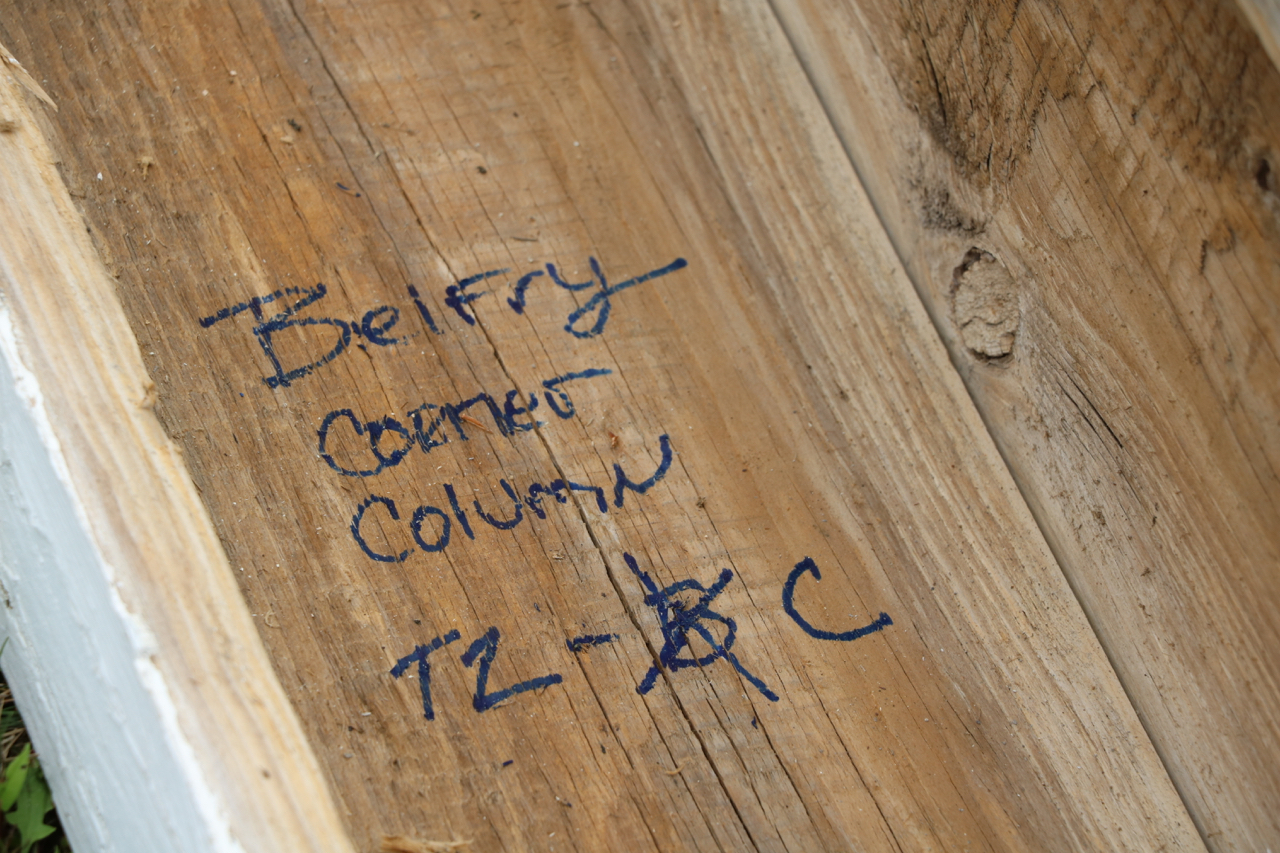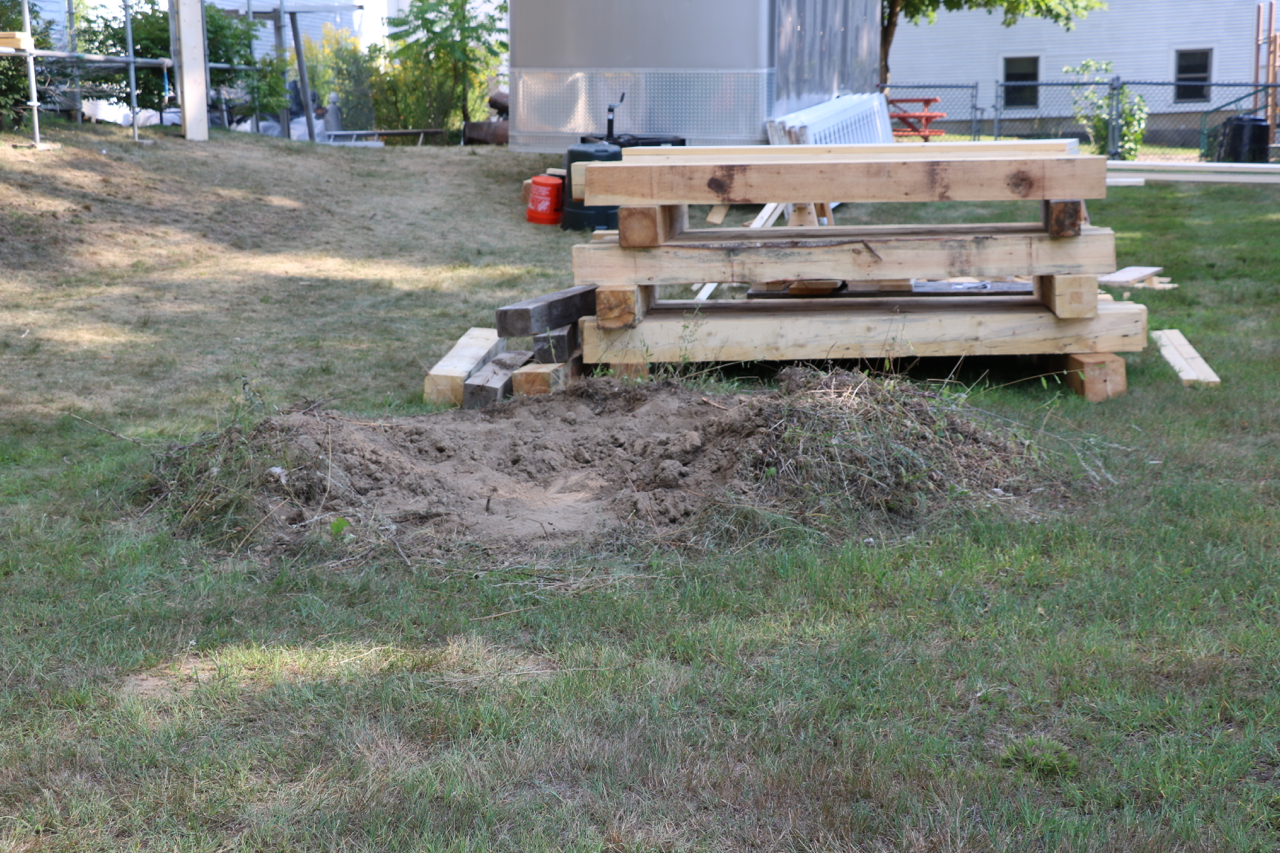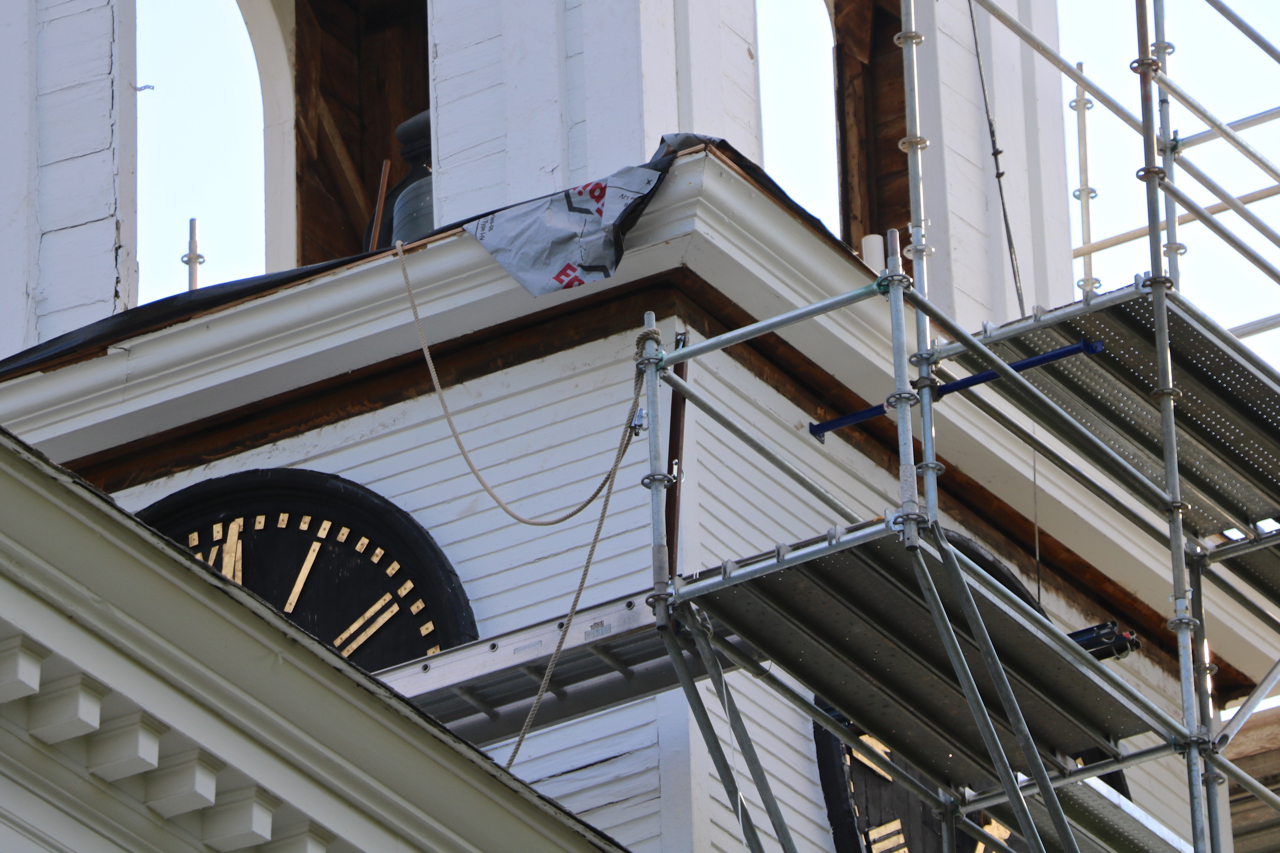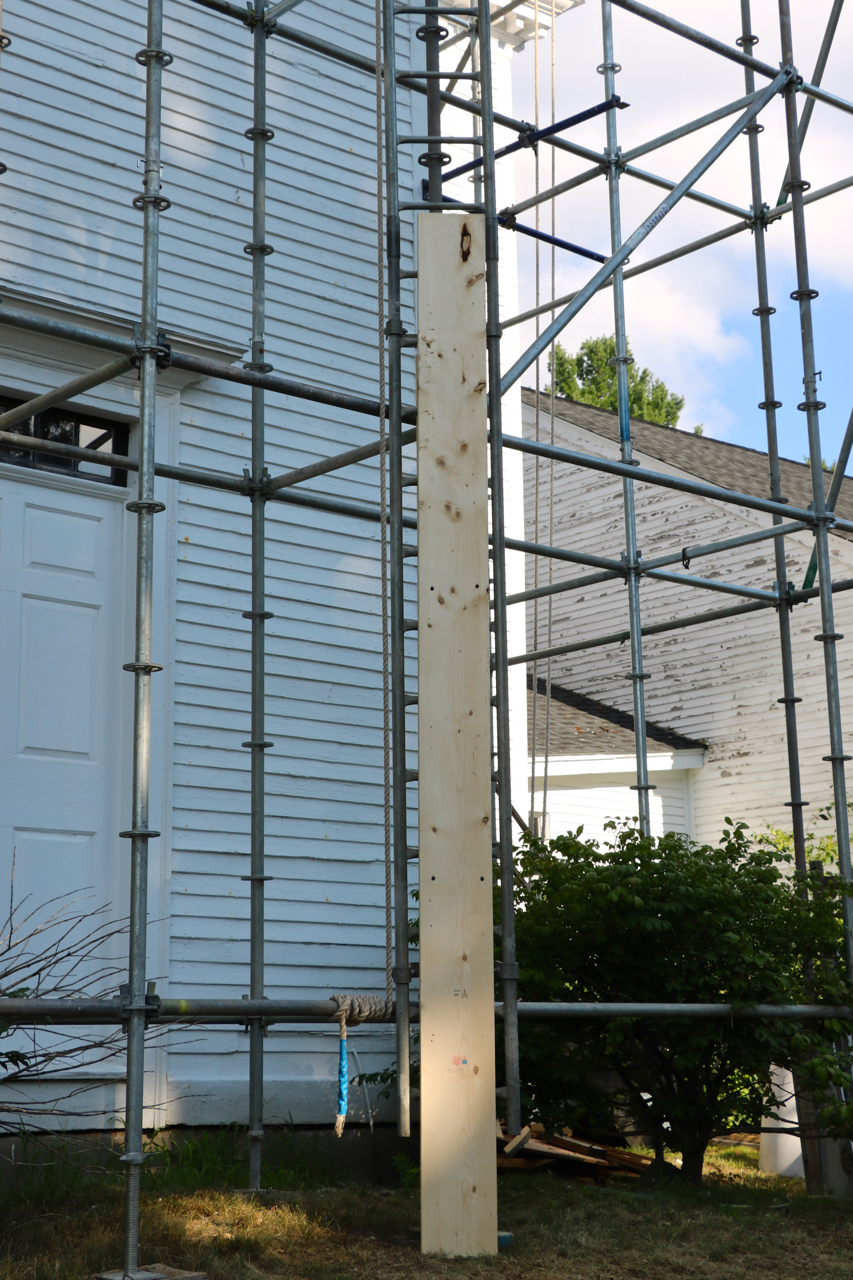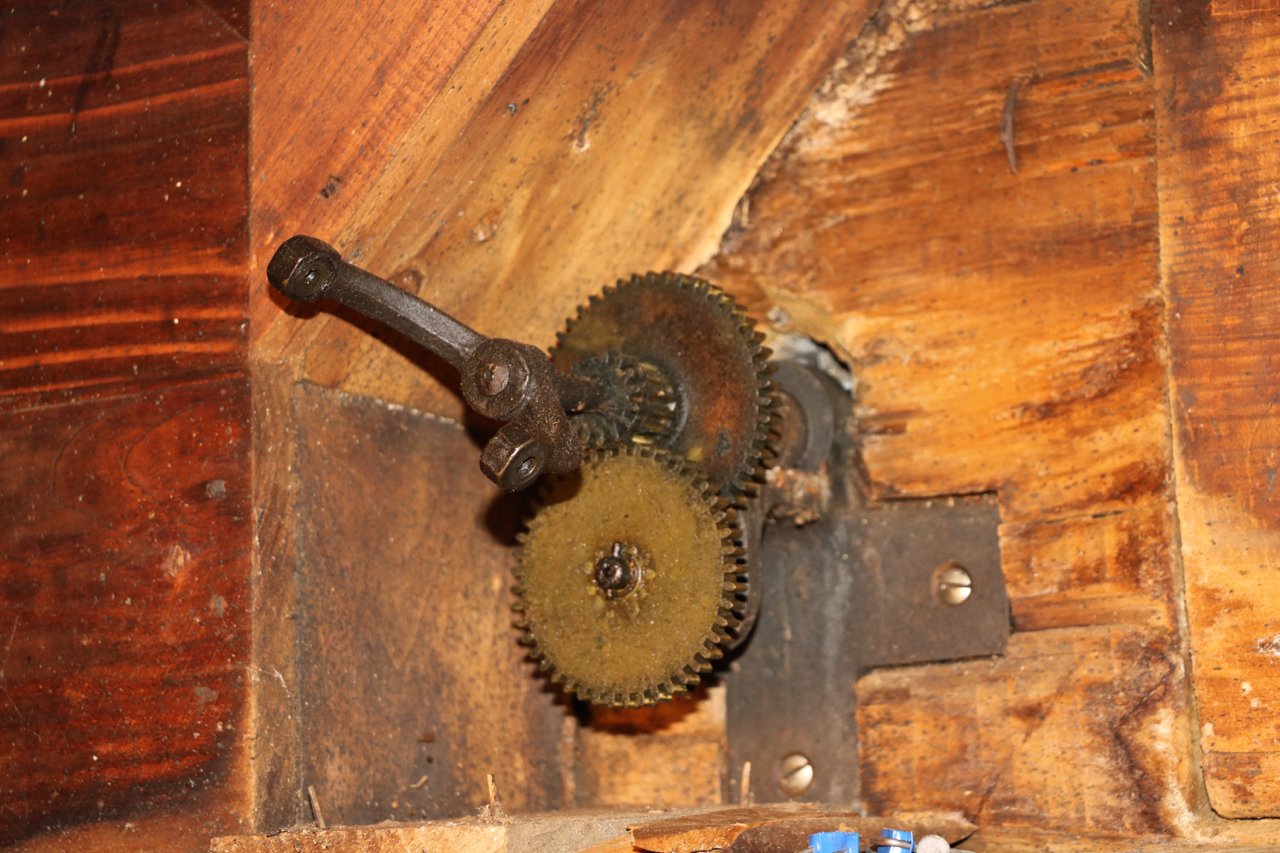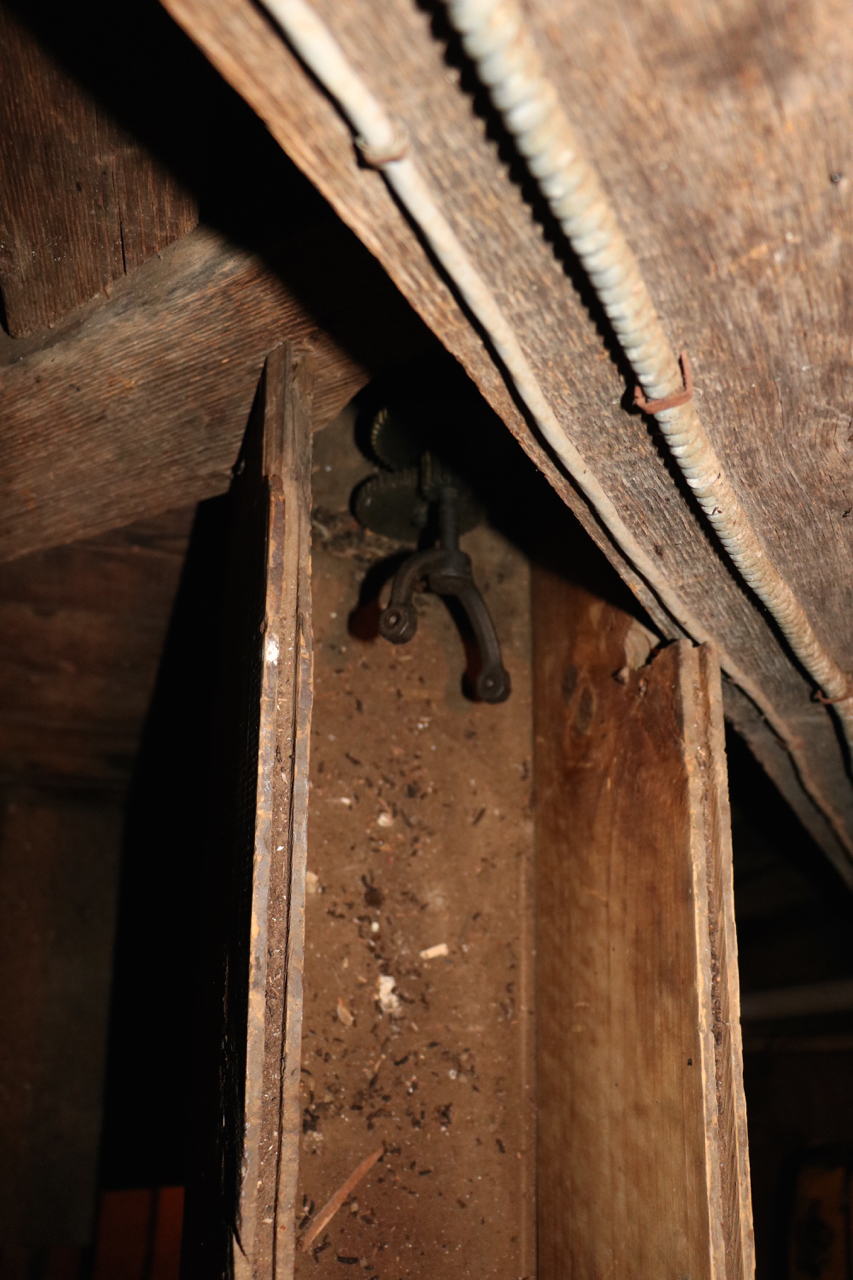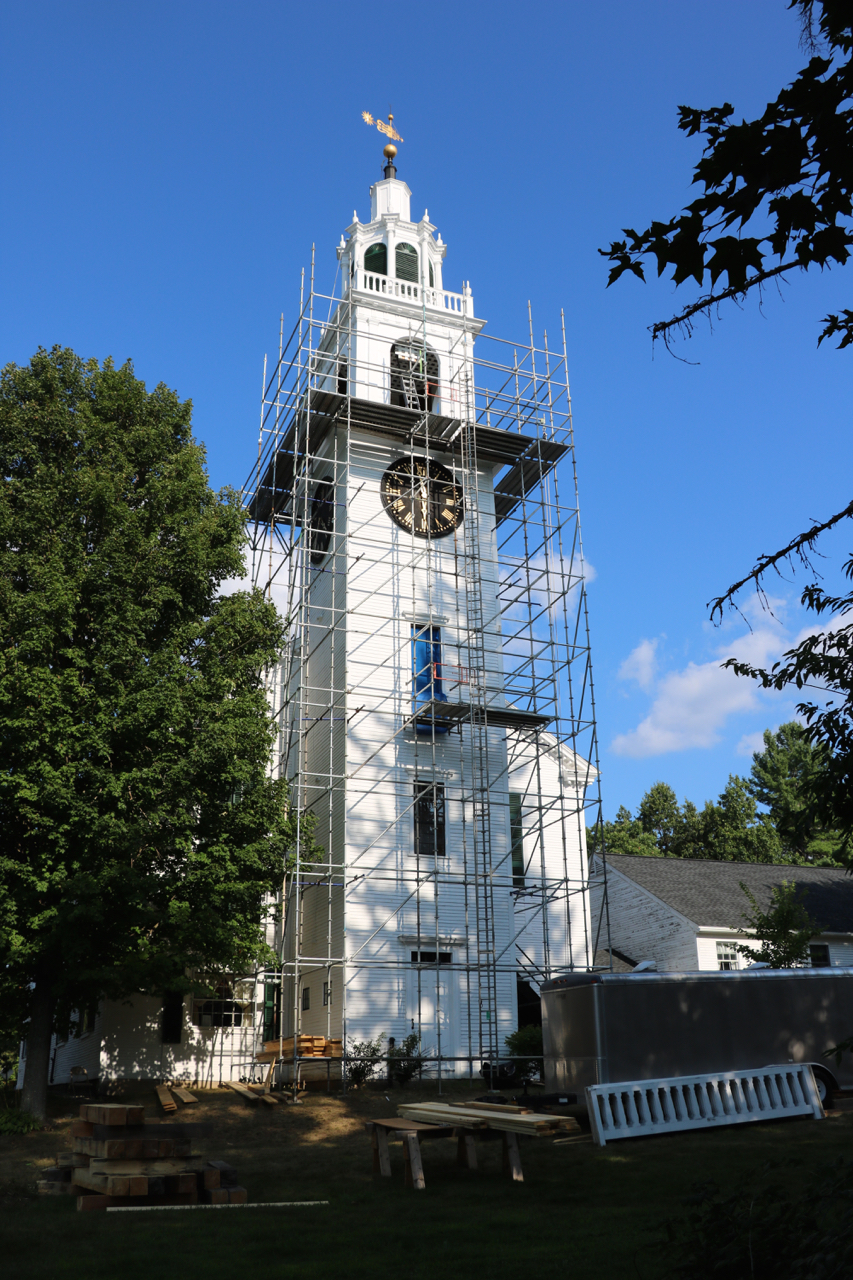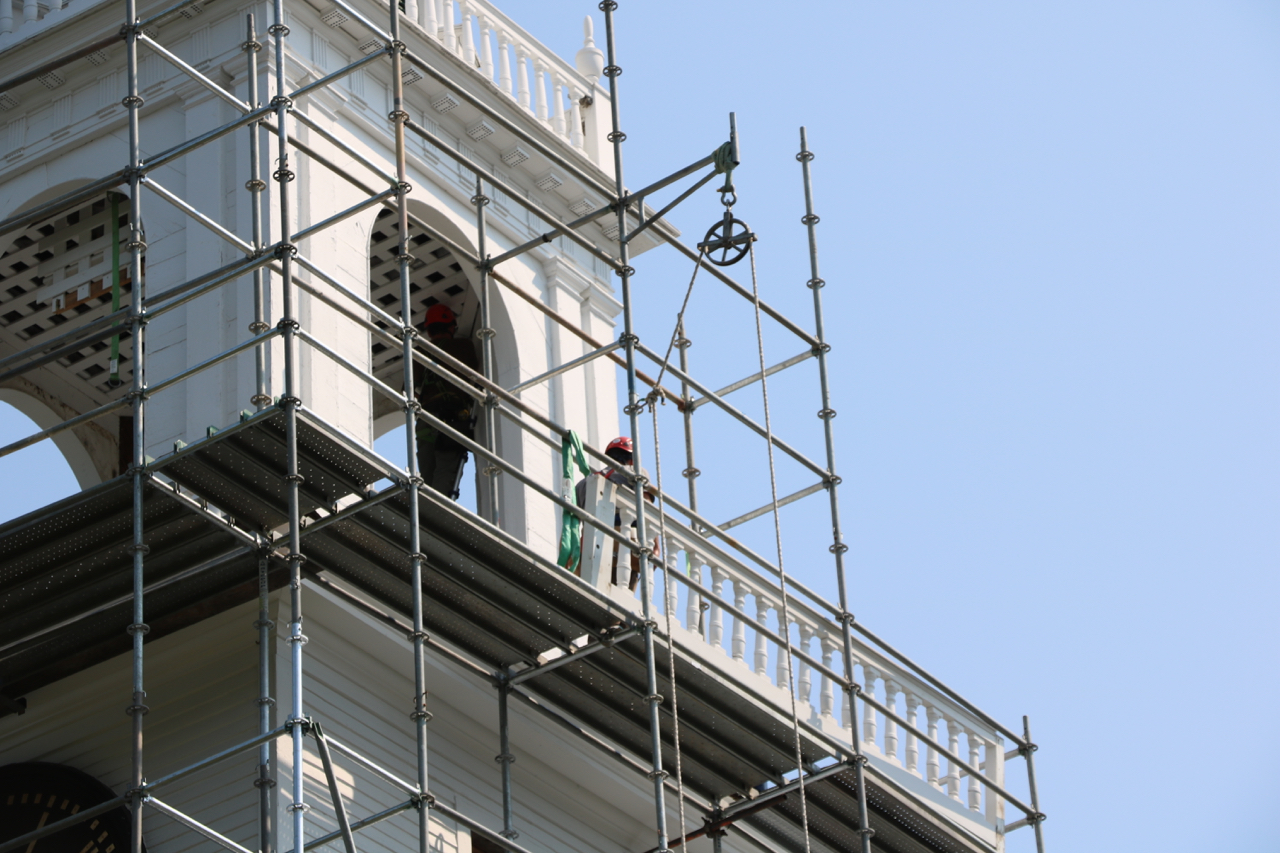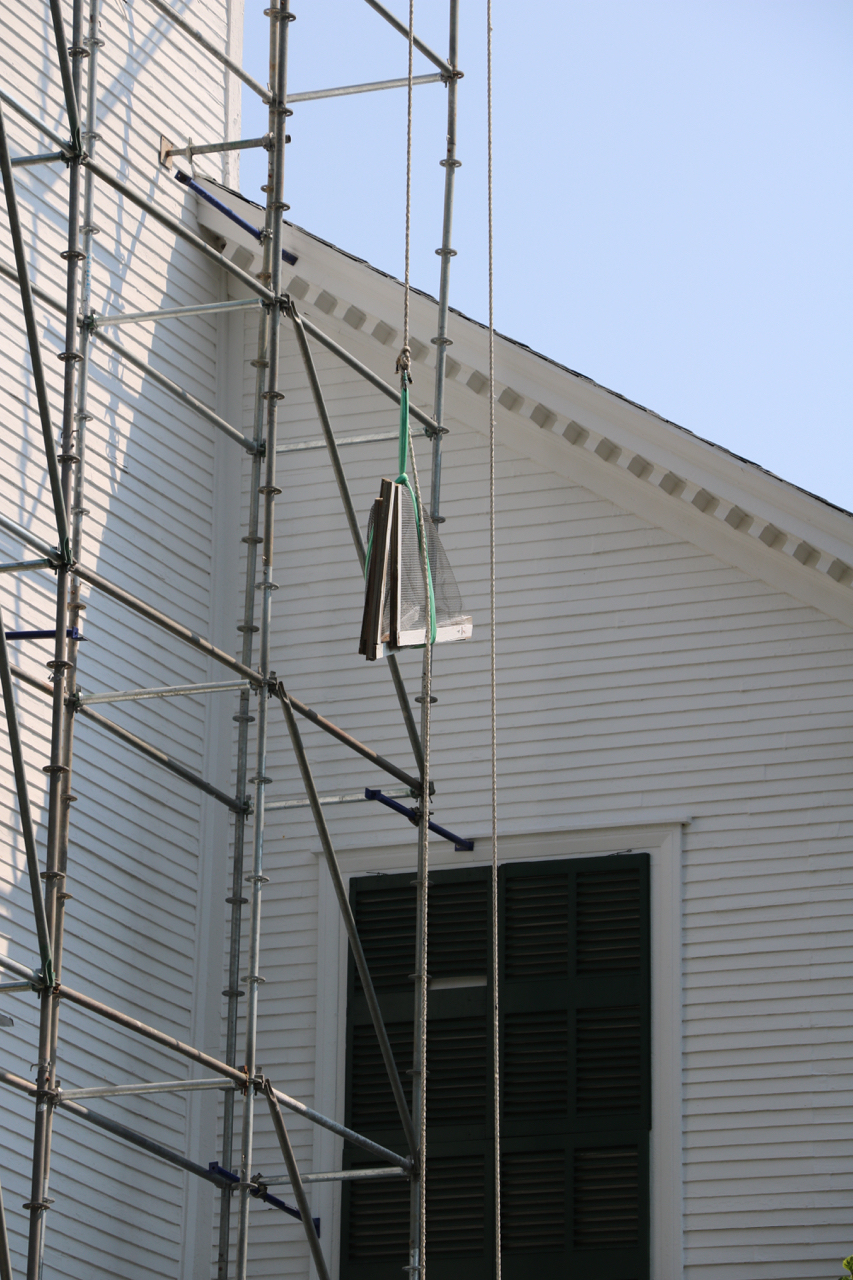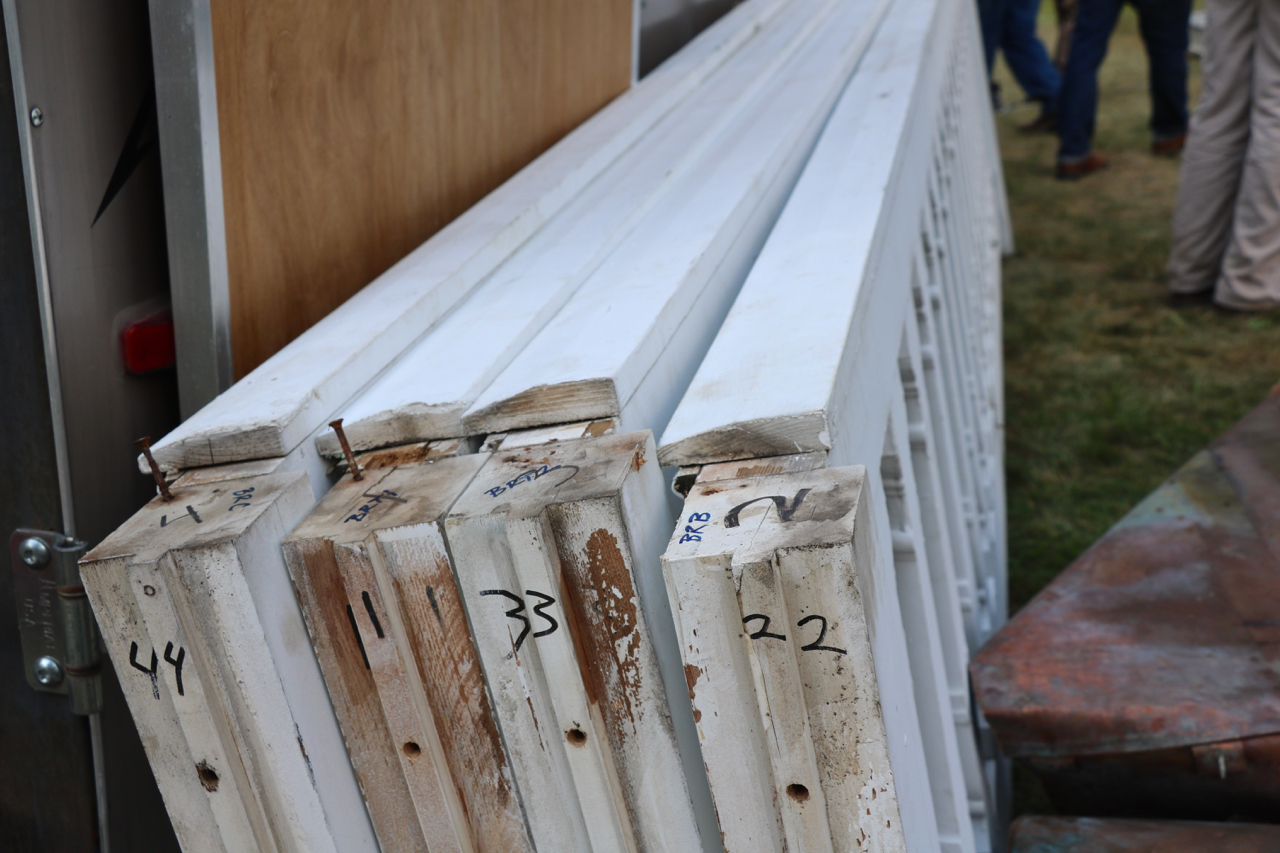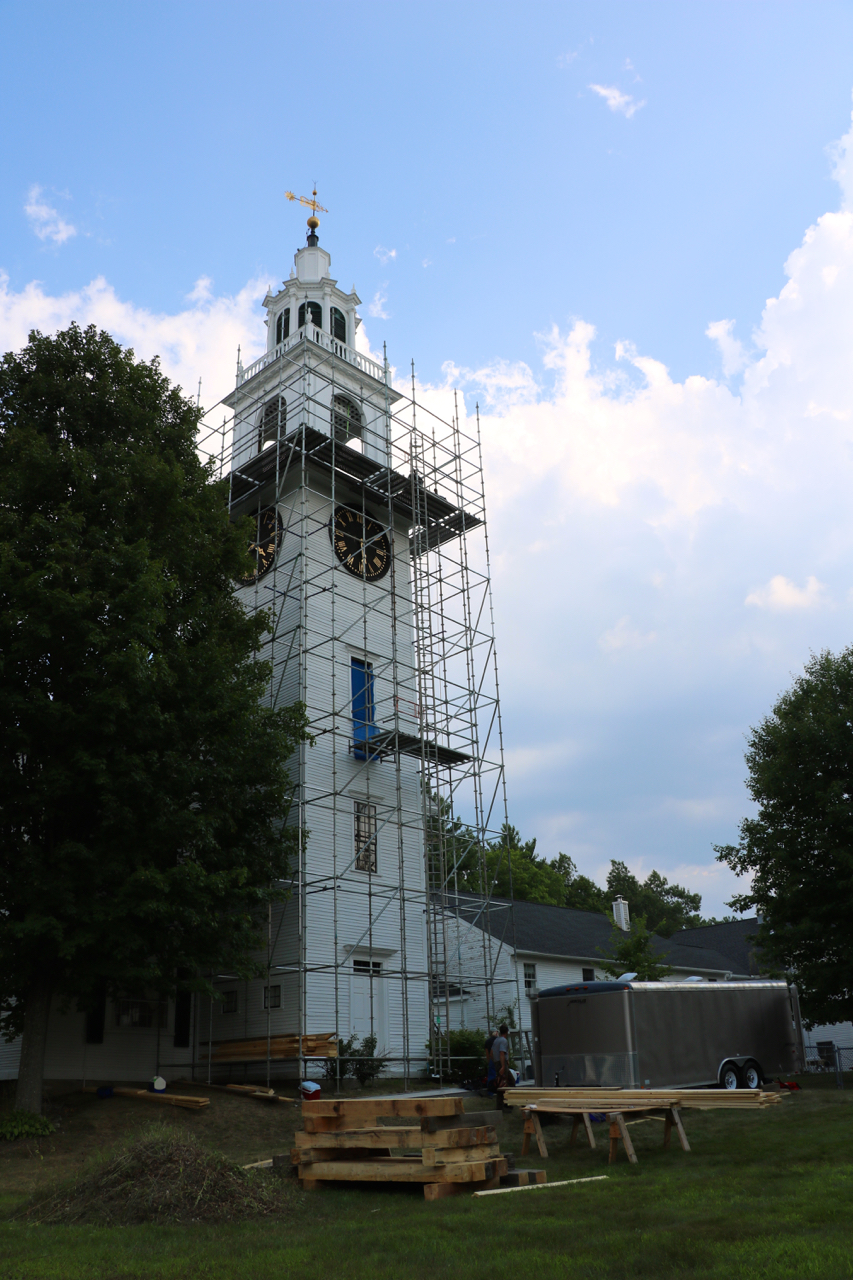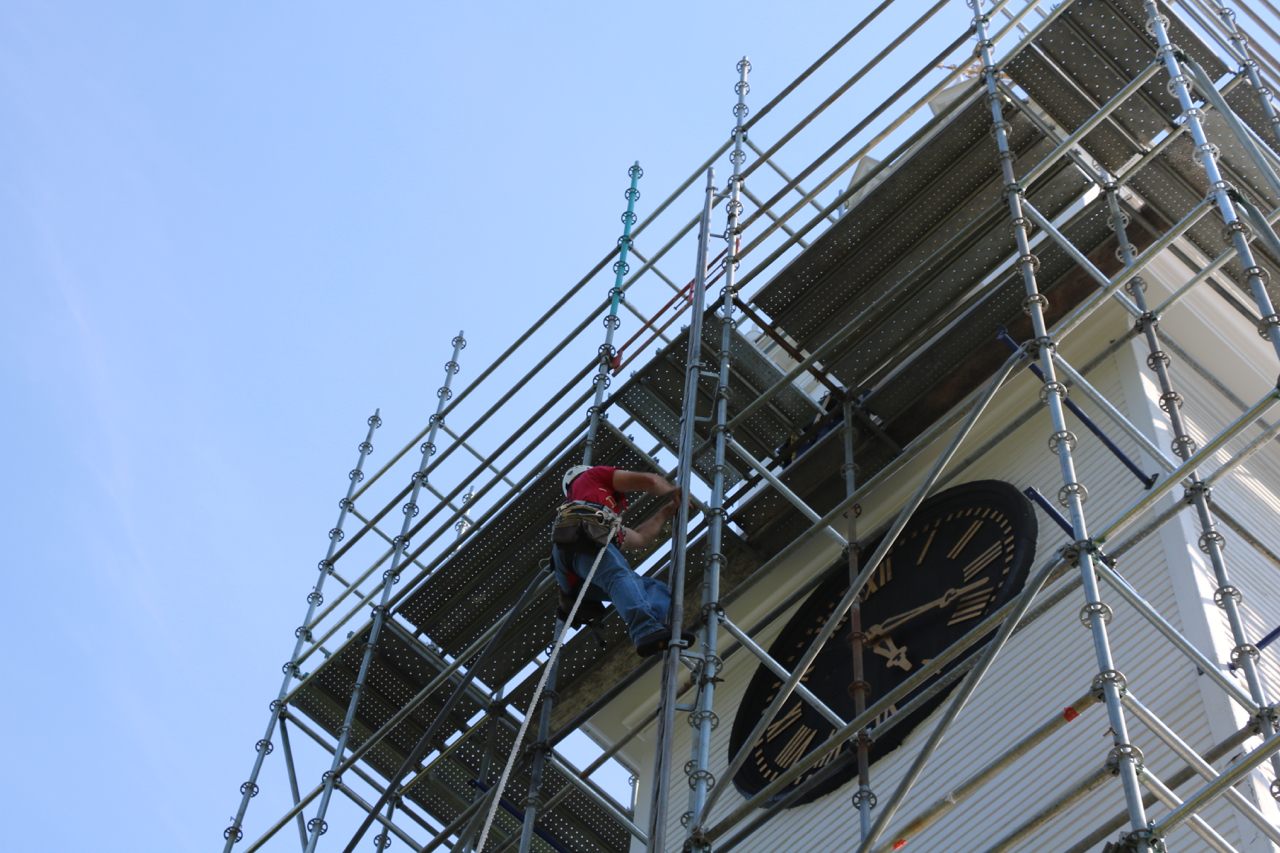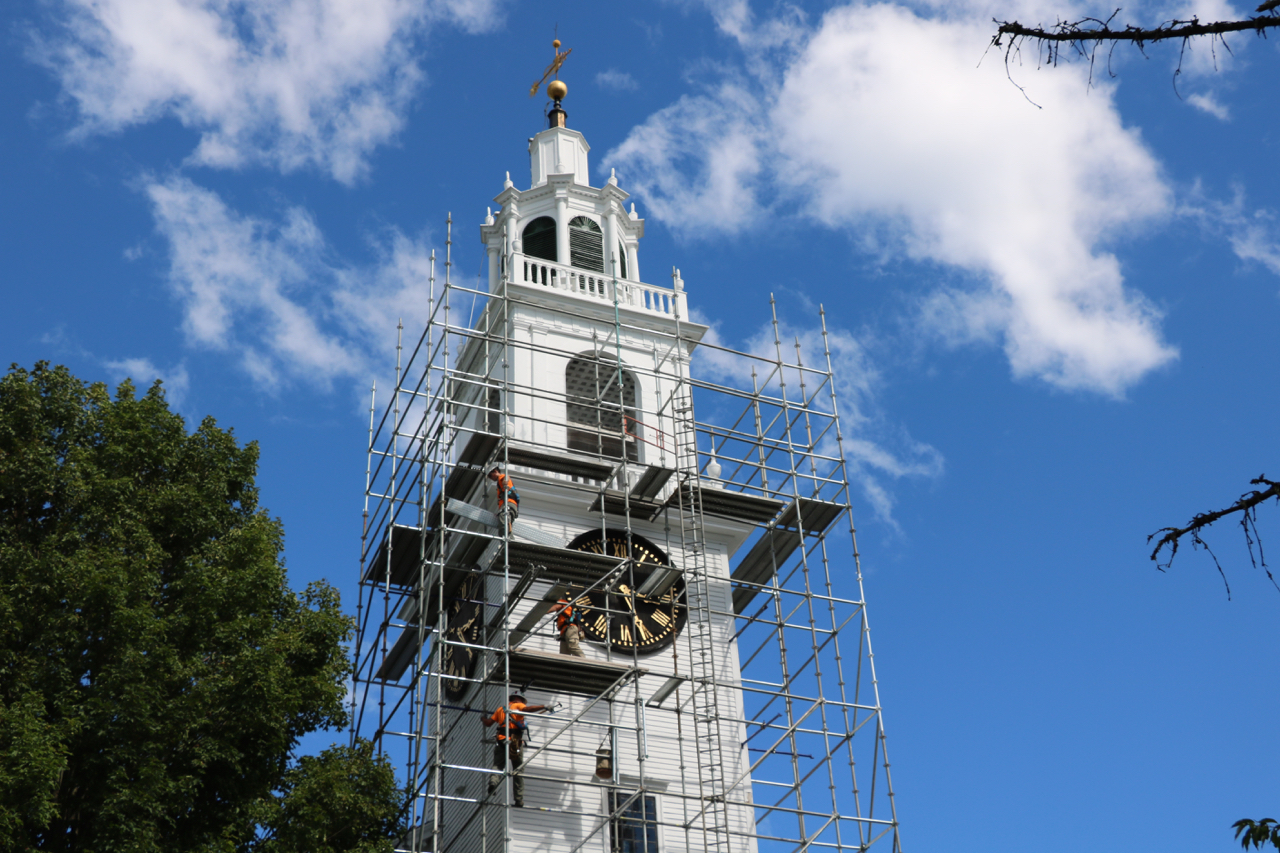
NUTFIELD HISTORY BLOG
Articles, news, and more
UPDATE – FPC Tower Takedown is Wed. Sept. 9
Some details on the Sept. 9th Tower Takedown, with photos from the site on Sept. 1st and 2nd.
September 2, 2015 – East Derry, New Hampshire — The removal of the damaged top of the First Parish Church Meetinghouse tower is now scheduled for:
Wednesday, Sept. 9, 2015, between 10:00 a.m. and 12:00 noon
The large crane will arrive Tuesday afternoon, and drive across the lawn to its position near the tower (special mats will help protect the grass). A trailer or two of counterweights will accompany the crane.
Preparations will begin early Wednesday morning with the lifting up of long bearing timbers (see photos below). These will rest on metal brackets attached to the belfry, and the Preservation Timber Framing (PTF) crew will through-bolt them to the belfry wall to support the top during the lift. The crane will be rigged to the timbers, and the top lifted off.
Because the belfry has long timber "legs" that nest down inside the tower base, the crane must actually lift it up very high. (The weathervane on top is firmly attached, and most likely will stay in place for the ride down.)
The crane will slowly lower the top down to timber cribbing waiting on the ground. The crew will attach side braces to safely hold the top in place while the crane still supports its weight. Once the top is secured to the cribbing on the ground, the crane will be released and move on to its next job.
That next job is to fly up the new roof that will seal the open top of the tower base. That roof is covered by a rubber membrane roofing material that will provide excellent weather protection for the two years it should take to return the restored top to the rehabilitated tower. (Batten strips on the roof surface, decorative gable/side panels, and other work will be done in time so that the roof looks a bit better than it does this week.)
After the new roof is flown up and secured, the crew may use the crane to remove the bell (which probably weighs about 1,200 pounds). This will depend on how much time is left in the day, and how quickly the tower top rigging can be changed for safe bell removal. If there's not enough time left, PTF will remove the bell another time (with a much smaller crane!).
Tower Takedown: Aug 27–31, 2015
Timbers, a roof, a tree, and clockworks.
Catching up here on recent work (as recorded in Facebook posts and copied here).
MONDAY AUGUST 31 — Preparations for the FPC Tower Takedown continued today. The top should "fly down" between 10:00 a.m. and noon on Wednesday Sept. 9th. The public is welcome (though safe viewing areas will be limited). It's rain or shine; only thunderstorms will delay things till Thursday,
The crane will arrive Tuesday afternoon and move in place on the front lawn (mats will help protect the grass). Wednesday work will begin early, with the lifting and setting of the long rigging beams through the belfry and other preparations for the lift. After the top comes down and is set in place, the bell will be removed, and then the new roof flown up to seal the tower base,
FRIDAY AUGUST 28 — At the FPC Meetinghouse Tower Takedown project, we sadly had to remove a maple too close to the Meetinghouse. The building looks happier without it, though. Read more in the captions.
THURSDAY AUGUST 27 — The beautiful E. Howard & Co. clockworks in the FPC Meetinghouse Tower is now protected for the Takedown. Brian Cox and others on the Preservation Timber Framing crew designed and built a custom, ventilated plywood box for this purpose.
Tower Takedown: Days 7-9, Aug. 24-26, 2015
More trim removal, and Takedown rescheduled to Sept. 9,
This week Ed Bell and the team from Preservation Timberframing continued the careful removal of the trim and damaged elements from the top sections of the tower.
This process has uncovered more of the tower's "guts," and the news has not been very good. The structural condition of the belfry and lantern is even worse than estimated, and so fairly extensive reinforcement work will soon commence.
Between the need for this extra work and challenges scheduling a large enough crane, the Takedown Day is rescheduled to Wednesday, Sept. 9th.
We will publicize a firm schedule for the day once the logistical plans are worked out, but it's looking like the flying down of the tower top will happen between 10:00 am and noon.
Tower Takedown: Day 6, Thursday Aug. 20
Today the Preservation Timber Framing experts focused on removing the bed and cove molding covering the joint between the belfry and the tower base.
First they had to adjust the staging platforms to work at this lower level, not easy 65' in the air. Then they very carefully removed each piece of trim to keep it intact. As with all the old elements of the tower, every piece of molding gets numbered and cataloged and will go into storage for its eventual refurbishment and placement back on the finished tower.
The crew also began to plan and build the new roof cap that will seal the tower after the takedown. They'll build it on the ground, and the crane will fly it up after lowering the top. (Unfortunately there's still not a firm commitment date from the crane company, but we're aiming for around Sept. 2nd.)
Ed Bell and the PTF crew must work at another job site tomorrow and will return to FPC Monday. They secured the scaffold ladder and covered the tower window openings with plastic for the long weekend.
FPC volunteers have also been hard at work. Paul Dionne led the effort to remove the pulley and cable for the clock-driving weight box. That pulley was attached to the clock room ceiling/belfry floor, and had to come down for the top separation. We unfortunately won't be able to keep the clock running during the rehabilitation work, so restoring its function in a couple years is an exciting milestone to look forward to.
Thanks also to volunteers Ken Gould who cleared the brush from the mound of dirt sitting right where we'll probably place the tower top, and to Bill Wheeler and Harry Carter who are making that dirt mound disappear.
Tower Takedown: Day 5, Aug. 19
Uncovering hidden timbers and continuing the great disconnect.
The heatwave continued today, but the powerful fans and emptied window openings help make the tower interior a little more tolerable. The seven-person Preservation Timber Frame crew led by Ed Bell continued working inside and out, removing more trim, siding, and other materials, to preserve them and expose the timber frame structure underneath (which none of us in recent years have ever seen).
FPC volunteer and clock works master Paul Dionne removed the shafts that drive the hands on the three clock faces. These will be stored safely with the clock works inside the tower. Later this week he'll remove the ceiling-mounted pulley and cable for the rock weight box that drives the clock, and then construct a box around the clock works to protect it.
Meanwhile volunteer Harry Carter has removed nearly all of the electrical system wiring so that the tower top will be free to fly away. He also installed a new outlet box at PTF's request (they have learned not to trust existing ancient outlets for their tools and lights). Bill Wheeler from the FPC Facilities Board also helped prepare for the takedown by coordinating the moving of fire alarm gear with the fire department.
PTF's extensive work is on track. But it turns out a larger crane is needed than originally expected, and so the Tower Takedown will probably happen around Sept. 2nd (rather than Aug. 26th).
Tower Takedown: Day 4, Aug. 18
The PTF crew continues to prepare the top.
Work continued on the rigging and preparation of the top for its removal.
PTF workers disassembled components and lowered them to the ground, including the belfry screening, railings, and its roof/floor. That roof originally consisted of cotton fabric that was shellacked and covered with wooden shakes. Later the shakes were replaced with copper. Today they took the copper off, and found it was placed over the original fabric. PTF will take the copper to a reclamation center, and the church will get some funds from i for future rehab!
New weight estimates for the Tower Top (37,000 pounds!) and its considerable height require a larger crane than originally thought. Reps from the new crane company visited today to check out the site, and we should have a date for the Takedown soon. (It very likely will be more like Sept. 2nd than August 26th.)
Tower Takedown: Day 3, Monday Aug. 17, 2015
PTF begins rigging and takedown prep.
Preservation Timber Framing began work to prepare the tower top for removal, investigating the structure and beginning to remove elements that are loose or otherwise should come down in pieces.
They brought in some large timbers for the cribbing that will hold the top securely on the ground, and lumber for internal reinforcements. The reinforcements are necessary because they found the condition of the top to be such that it needs help to stay intact during its removal.
Editor Julie Huss from the Derry News interview Arron about the project. She had interviewed Pastor Deborah last week, and will probably publish an article on the takedown effort this week.
Steeple Coming Down at First Parish Church in East Derry, New Hampshire
The Tower Top Takedown is Sept. 9, 10:00am–12:00 noon. Major rehab efforts on the FPC Meetinghouse get started in late August, 2015, with the takedown of the damaged top part of the tower.
UPDATE — Takedown Day is now scheduled for Wed. Sept. 9. The "flying down" of the tower top should be between 10:00am and 12:00 noon. See more updates on the Project Page.
Press Release – EAST DERRY, NH – August 13, 2015 – A very visible step in the effort to preserve a significant New Hampshire landmark will soon take place with the lowering of the steeple at First Parish Church (FPC) in East Derry.
On or about Wednesday, August 26, timber frame experts will make the final detachments and a large crane will lower to the ground the top two sections of the tower on the historic FPC Meetinghouse. The belfry and lantern will be placed in secured staging on the lawn, and a temporary roof will be lifted up and installed above the clock, which will remain in place.
It will take two years to complete the restoration work and reunite the top sections with the rest of the tower.
Rehabilitating an Historic Landmark
Built in 1769, with the current tower added in 1824, the timber frame Meetinghouse appears to be in remarkably good condition but actually needs an estimated $1.5–$2M in repairs. The tower structure is especially deteriorated, and the top sections must come down now before the weather potentially takes them down this winter.
This work on the tower is part of a multi-year effort to rehabilitate the historic Meetinghouse, ideally in time for the 300th anniversary of the church and Derry’s founding in 2019. Plans call for:
- Lifting the building to rebuild its foundation and adding an adjacent elevator for full accessibility throughout the facility in 2016,
- Repairing the timber frame and slate roof in 2017, and
- Restoring and rehabilitating the interior finishes in 2018.
“The meetinghouse at First Parish is one of the most beautiful and significant 18th century New Hampshire buildings still in active use. We applaud and support the church’s dedication and perseverance in beginning this rehab effort, and look forward to seeing their great results over the next three years.”
The tower top itself will be repaired and restored while on the ground, and be reunited with the rehabilitated tower base after the Meetinghouse foundation work is completed in the fall of 2017.
Initial funding for the Tower Takedown and early rehab projects comes from years of preservation donations and a recent $800,000 capital campaign drive within the church. A community-oriented fundraising effort launching soon and various grants will hopefully contribute towards the remaining costs; FPC has submitted a 2015 NH state LCHIP application to cover part of the $300,000 estimated cost of rehabilitating the tower alone.
“Our church has been a trustworthy steward of ‘The Old Meetinghouse on the Hill’ for two and a half centuries,” said the Rev. Dr. Deborah Roof, pastor of First Parish Church. “We look forward to sharing this rewarding challenge with the community through several dramatic rehabilitation projects that all begin now with taking down the damaged parts of the steeple.”
About the FPC Meetinghouse
“The First Parish Church Meetinghouse is one of the most significant and inspiring timber framed structures in New England. The peaceful removal of the damaged belfry and lantern frames from the tower begins a comprehensive and thoughtful preservation of the entire historic structure. We look forward to working closely with FPC as they ready the building for their 300th birthday in 2019.”
The current FPC Meetinghouse was constructed in 1769 to replace an earlier structure built by the area’s first settlers. It has served as a civic, community, and religious center for almost 250 years, and today is home to the vibrant First Parish Congregational Church UCC (United Church of Christ). Along with two modern FPC buildings, the Meetinghouse is host to concerts, social gatherings, history events, a preschool, and the regular meetings of dozens of community groups.
“The First Parish Church is the cornerstone of our towns founding. It stands high on the hill where the first settlers lived and has been a consistent reminder of our great heritage. I’m so excited to see the preservation project get underway and look forward to watching it bring new life to the building.”
With its hilltop location along a heavily traveled road, the Meetinghouse epitomizes the classic New England village church and is a well-known and much-appreciated regional landmark. It anchors the East Derry Historical District—placed on the National Register of Historic Places in 1982—and is thought to be the oldest structure in town and one of the oldest New England meetinghouses still operating.
Learn more about First Parish Church, the Meetinghouse’s history, the multi-year rehabilitation project, and how to contribute by visiting www.fpc-ucc.org.
# # #
First Parish Congregational Church, UCC
47 E. Derry Rd., P.O. Box 114, East Derry, NH 03041 • (603) 434-0628
Tower Takedown: Days 1 & 2, Aug, 12–13
Staging goes up to provide access for takedown prep.
The exciting work to remove the damaged top sections of the First Parish Church Meetinghouse tower began on Wednesday with the preparation of staging to allow safe access to the structure.
Seacoast Scaffold & Equipment Corporation's crew arrived early, and parked as close as they could get to unload the large load of scaffolding elements. Hand carrying the heavy pieces from Cemetery Rd. to the base of the tower took two or three hours, while the foreman measured and for the exact location of the staging and prepared a solid base.
Building the staging then proceeded pretty quickly, reaching about the halfway point by day's end.
Thursday morning the scaffold crew returned and put in a hard long day, completing the staging a day earlier than anticipated.
Also on Thursday members of the FPC Building Advisory Committee* met with Preservation Timber Frame's president Arron Sturgis and our project foreman Ed Bell to plan remaining details for the takedown. Joining in the planning session were Pastor Deborah Roof, and volunteers Paul Dionne (tower clock guardian) and Harry Carter (master craftsman and electrician).
Everything was then ready for the PTF's rigging and preparatory work next week.
* The FPC Building Advisory Committee (BAC) is Paul Ambler (chair), Nancy Heywood, Larry Krantz, Paul Lindemann, and Bill Mann.
Why the First Settlers Came to Nutfield
Early movements of the First Settlers, from Ireland to Boston, Maine, and Nutfield
It’s almost sunset on a hot July 28th, 1688, and a twelve-year-old boy is climbing stairs to the highest point in the walled city of Derry, Ireland.
He’s no doubt thinking of the several thousand soldiers and residents who recently died within those walls, on this the 105th day of a terrible siege. Rations are scarce—there are few dogs left alive in the city—and only two days worth remain.
Nearing the top, the boy can hear cannon and musket fire from a couple of miles down the calm river Foyle. Emerging at the top of the cathedral tower, he can just see the great battle going on downstream. There, a wooden and chain boom stretches shore to shore, blocking the relief ships sent by King William and Queen Mary, Protestant rulers in England.
The boom was built and defended by the French and Irish army of deposed Catholic King James II. He had promoted Catholicism and threatened the Protestant establishment during his brief reign, and had been banished to France. His attempt to regain the throne centered on taking over Northern Ireland, and until now his forces had been quite successful.
The boy on the tower and his family and many other faithful Presbyterian Protestants had fled to the safe walls of Dublin to escape the Catholic army sweeping the Irish countryside. Soon he sees the answer to their prayers, as the British ships break through the boom and sail towards the city. With great joy and excitement he fires a signal cannon to let the famished residents know that relief is on its way. Two days later and the Catholics give up, abandon the siege—and the war—and a defeated King James heads back to France.
That twelve-year-old boy was James MacGregor, who would go on to found what became Derry and our First Parish Church.
The Scots-Irish migrated from the lowlands in Scotland to the new Ulster Plantation in Northern Ireland.
MacGregor’s immediate ancestors had been among the 100,000-plus Presbyterians moving from the Scottish Lowlands to Northern Ireland between 1607 and 1697. They occupied the farms and towns of the defeated local Irish Catholics, at the invitation of the Anglican Protestant King of England and Scotland.
That king’s motivation in establishing this Ulster Plantation was to use the less-unfriendly Scottish Presbyterians to create a buffer between England and the unruly Irish Catholics. This was a great economic success, but Irish/Protestant tension in Ulster oscillated through the decades, peaking in 1688 with the terrible Siege of Derry we just glimpsed.
War left MacGregor determined to pursue a life devoted to peace. In 1701 he became a pastor in Aghadowey, a small village near Derry, and there lead a decidedly Scottish Presbyterian congregation for many years.
Meanwhile, Ulster became the most economically successful part of Ireland and began to rival England. The concerned British rulers took steps to control the economy and force the state-sanctioned Anglican Protestant religion on all the Presbyterian residents. This made religious and economic life more and more challenging for the Ulster Scots, and lead to yet another migration, this time to the New World.
In the spring of 1718, Rev. MacGregor and sixteen families from his congregation—probably about 300 people—left Belfast on the British ship Robert and sailed to Boston. They were first offered land in Maine along Casco Bay, and the Robert took most of the group north to check it out. They ended up stuck there for the winter, freezing and starving, until an offer of new land finally came. The Robert sailed down to the Merrimack River and landed at Haverhill on April 2nd, and a group of men proceeded North to the flock’s new home, Nutfield.
This was a 12 square mile tract known for its plentiful nut trees and rich potential farm land. The governor in Massachusetts gave them this territory in part to create a buffer between the native Indians and the more civilized establishment in Boston. This sort of attitude would persist for many years, as our resilient band of Scots-Irish settlers continually sought to clarify that they were Presbyterian Scottish immigrants, not the even more scorned Irish Catholics.
Finding Nutfield satisfactory, most of the men returned to Haverhill to fetch their families. Some of the party returned via Dracut to pick up Rev. MacGregor, who hadn’t gone to Maine with the congregation, and instead spent the winter teaching in Dracut. They all arrived there on April 11.
Sketch from Willey's Book of Nutfield (page 52) depicting the First Sermon.
The next day, April 12, 1719, Rev. MacGregor gathered everyone under an oak tree on the east shore of Beaver Lake and preached the First Sermon. This marks the founding of our church.
Nutfield grew vigorously from that point on, becoming a formal town and changing names from “Nutfield” to “Londonderry” in 1722. Much later, in 1827, a religious split led to a departure of many from our congregation to the West Parish, where they kept the town name Londonderry and Derry was incorporated as it is today.
The challenging move of the middle-aged Aghadowy congregation to New England was less “grand adventure” and more “the lesser of two evils.” In a sermon the night before their departure, Rev. MacGregor gave these four reasons for leaving their home:
- “To avoid oppressive and cruel bondage,”
- “to shun persecution and signed ruin,”
- “to withdraw from the communion of idolaters,” and
- “to have an opportunity of worshipping God according to the dictates of conscious and the rules of his inspired Word.”
This vision of religious freedom helped our First Settlers to persevere through very tough times, as had the same spirit helped their ancestors back in Scotland and Ireland.
There is much more to the story of our founding First Settlers. Derry Town Historian Richard Holmes tells the full story in his book Nutfield Rambles. Find it in our local libraries, or read a free excerpt online at Londonderry Hometown Online News.
Read much more about the religious history and background in Scotch And Irish Seeds In American Soil.
Follow the story of the settlement in Nuffield as told in 1890 in Scotch-Irish In New England.



